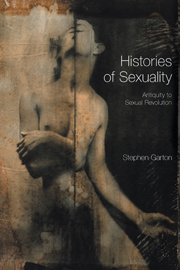Book contents
- Frontmatter
- Dedication
- Contents
- Preface
- 1 Writing Sexual History
- 2 Rule of the Phallus
- 3 Sexual Austerity
- 4 Christian Friendships
- 5 Making Heterosexuality
- 6 Victorianism
- 7 Dominance and Desire
- 8 Feminism and Friendship
- 9 Imagining Perversion
- 10 Normalizing Sexuality
- 11 Sexual Revolution
- Epilogue
- Endnotes
- Select Bibliography
- Index
1 - Writing Sexual History
- Frontmatter
- Dedication
- Contents
- Preface
- 1 Writing Sexual History
- 2 Rule of the Phallus
- 3 Sexual Austerity
- 4 Christian Friendships
- 5 Making Heterosexuality
- 6 Victorianism
- 7 Dominance and Desire
- 8 Feminism and Friendship
- 9 Imagining Perversion
- 10 Normalizing Sexuality
- 11 Sexual Revolution
- Epilogue
- Endnotes
- Select Bibliography
- Index
Summary
Sex is one of the few things about which historians can be certain. Without heterosexual penetration we would not be here to ruminate on the past. Of course, there is much more to sex, even heterosexual sex, than reproduction. But for many historians, sex is a constant – outside history. For a discipline committed to charting social, political and economic change, sex was something biological, natural and beyond historical inquiry. What is the point of writing about something that happened in all times and places? Instead sexual practices found their way into history through other means. For some social reformers, such as Margaret Sanger and Howard Brown Woolston, reflections on the history of birth control or prostitution served to underpin claims for legislative change. These histories, written by reform-minded amateurs rather than professional historians, served to illustrate the errors of the past. More common amongst University-based historians was the tradition of subsuming sex within a wider concern with morality. Pioneering nineteenth-century historians, such as William Edward Hartpole Lecky, made the history of European morals a legitimate area of inquiry, one properly subject to observable patterns of change over time. Such an approach, however, made moral codes historical, leaving sexual behaviour timeless and unchanging.
While many historians, until the 1970s, accepted the force of biological and psychological theories of sexuality, other disciplines were very interested in the cultural webs that entangled the sex drive – courtship rituals, sexual initiation rights, marriage customs, religious sanctions, superstitions, beliefs, childbirth practices, and child-rearing traditions.
- Type
- Chapter
- Information
- Histories of SexualityAntiquity to Sexual Revolution, pp. 1 - 29Publisher: Acumen PublishingPrint publication year: 2004



